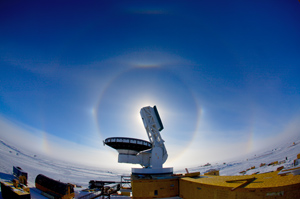|
||
      |
First light focuses on dark energy
The University’s South Pole Telescope searches for clues to the early universe.
Scientists have aimed the University’s South Pole Telescope (SPT) at Jupiter and collected the instrument’s first test observations. Soon a far more distant quarry will fall under the telescope’s sights as the team tackles one of the biggest mysteries to beset modern cosmologists—the nature and origin of dark energy.

In Antarctica's cold, dry air the telescope can better detect the big bang's afterglow.
“The telescope, camera, and optics are all working as designed,” said John Carlstrom, the S. Chandrasekhar distinguished service professor in astronomy & astrophysics and the College, who heads the nine-institution SPT team. Reaching “first light”—the moment light initially passes through the telescope, making it operational—this past February was “a major milestone for the project and is a fitting conclusion to a remarkably productive summer season for the South Pole Station,” Carlstrom said. “We now look forward to fully characterizing the instrument and beginning cosmological observations.”
Designed to help unravel dark energy, a nebulous force that dominates the universe, the SPT may help determine whether the concept Einstein considered his biggest mistake was actually one of his greatest achievements. Dark energy might be Einstein’s cosmological constant: a steady force of nature operating at all times and places. The physicist introduced the idea into his theory of general relativity to accommodate a stationary universe, the dominant idea of the day. After Edwin Hubble’s 1929 discovery that the universe in fact was expanding, Einstein called the idea his greatest blunder. Yet it may have been no blunder if dark energy turns out to be the cosmological constant.
In the late 1990s astronomers, using exploding stars as cosmic tape measures, found that the universe’s expansion was accelerating. The discovery led to the idea that dark energy pushes the universe apart, besting gravity. The SPT’s findings could help solidify that theory.
Primary funding for the $19.2 million telescope comes from a 2002 National Science Foundation grant. Standing 70 feet tall, 33 feet across, and weighing 280 tons, the telescope was test-assembled in Kilgore, Texas, then taken apart, shipped to New Zealand, and flown to the South Pole, where, since November, the team has reassembled and deployed the instrument.
The South Pole’s cold, dry atmosphere helps the SPT more easily detect cosmic microwave background (CMB) radiation, the big bang’s afterglow, with minimal interference from water vapor. The telescope will analyze the CMB to study the evolution of galaxy clusters. Because dark energy seems to push everything apart, it inhibits the clusters’ growth; studying how they developed may reveal information about dark energy. The SPT will look for the imprint the clusters have left as the CMB has moved through space.
In the CMB astronomers can view traces of the infant universe, when it was 400,000 years old and no stars or galaxies had yet formed. If dark energy changed the way the universe expanded, it would have left its fingerprints in how it forced galaxies apart over time. Different causes would produce a different pattern of galaxy-cluster formation.
To pinpoint when dark energy became important, the SPT will observe the Sunyaev-Zeldovich (S-Z) effect, a distortion of the CMB as it passes through the hot gas of intervening galaxy clusters. Some of the microwaves, as they interact with the gas, change in frequency. The SPT will measure the slight temperature difference associated with the frequency change and produce an image of the gas in the cluster.
Scientists expect the SPT, which can scan about one square degree of the sky in less than an hour (a full moon covers about half a degree), to detect thousands or even tens of thousands of galaxy clusters within a few years. “To get a meaningful constraint on dark energy through measuring galaxy clusters, you need something like this South Pole Telescope for the S-Z work,” Carlstrom said. “The cluster S-Z signals cover small patches of sky relative to the intrinsic variations in the cosmic microwave background. To get some resolution, you need a big telescope. Now we have one.”